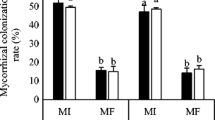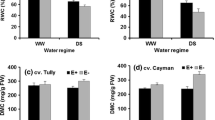Abstract
Neotyphodium, a seed-transmissible nonpathogenic fungal endophyte (symbiont) is considered beneficial because endophyte-infected grasses are more drought-tolerant, produce more dry matter, utilize soil nitrogen more efficiently, and deter insects. In this study, the effects of endophytes on physiological mechanisms of drought tolerance in tall fescue (Festuca arundinacea Schreb.) were studied in a greenhouse. Two clonally propagated genotypes of tall fescue (F. arundinacea Schreb.), naturally containing endophyte (EI), and their endophyte-free ramets (EF) were tested at three water stress treatments exerted by PEG 6000 in a hydroponics system. Relative water content (RWC), cell membrane stability (CMS), proline and chlorophyll contents in plant leaves were measured during water stress treatments. After harvest, K+, Ca2+, and Mg2+ contents were measured in plant roots and shoots. After 20 days under stress conditions, plants were transferred to basal hydroponics medium, and their survival after stress relief was evaluated. The results showed that endophyte considerably contributes to host grass water stress tolerance. Both genotypes of EI and EF plants did not differ in RWC, but, regardless of the infection status, genotype 75 had the higher RWC than genotype 83. EI clones of both genotypes maintained slightly higher chlorophyll content and membrane stability than EF clones, although these differences were not significant. The EI plants of genotype 83 concentrated significantly more proline than EF plants, but in the genotype 75, differences between EI and EF clones were not significant. Plant mineral absorption was also influenced by the endophyte presence. EI clones had the higher concentrations of K+ in the shoots of both genotypes. The Mg2+ and Ca2+ contents in EF plants of both genotypes were higher than EI plants in the roots, but in the shoots there were no differences between EI and EF clones. EI clones survived longer after stress removal. These results strongly suggest that Neotyphodium endophytes exert their effects on tall fescue drought tolerance through alteration of various physiological mechanisms involved.
Similar content being viewed by others
Abbreviations
- CMS:
-
cell membrane stability
- EF:
-
endophytefree
- EI:
-
endophyte-infected
- RWC:
-
relative water content
References
Thompson, F.N., Stuedemann, J.A., and Hill, N.S., Anti-Quality Factors Associated with Alkaloids in Eastern Temperate Pastures, J. Range Manage, 2001, vol. 54, pp. 474–489.
Glenn, A.E., Bacon, C.W., Price, R., and Hanlin, R.T., Molecular Phylogeny of Acremonium and Its Taxonomic Implications, Mycologia, 1996, vol. 88, pp. 369–383.
Piano, E., Bertoli, F.B., Romani, M., Tava, A., Riccioni, L., Valvassori, M., Carroni, A.M., and Pecetti, L., Specificity of Host-Endophyte Association in Tall Fescue Populations from Sardinia, Italy, Crop Sci., 2005, vol. 45, pp. 1456–1463.
Schardl, C.L. and Wilkinson, H.H., Microbial Endophytes: Hybridization and Cospeciation Hypothesis for the Evolution of Grass Endophytes, Microbial Endophytes, Bacon, C.W. and White, J.F., Eds., New York: Marcel Dekker, 2000, pp. 63–83.
Christensen, M.J., Bennett, R.J., and Schmid, J., Growth of Epichloe/Neotyphodium and P-Endophytes in Leaves of Lolium and Festuca Grasses, Mycol. Res., 2002, vol. 106, pp. 93–106.
Schardl, C.L., Leuchtmann, A., and Spiering, M.J., Symbioses of Grasses with Seedborne Fungal Endophytes, Annu. Rev. Plant Biol., 2004, vol. 55, pp. 315–340.
Lyons, P.C., Evans, J.J., and Bacon, C.W., Effect of the Fungal Endophyte Acremonium coenophialum on Nitrogen Accumulation and Metabolism in Tall Fescue, Plant Physiol., 1990, vol. 92, pp. 726–732.
Belesky, D.P. and Fedders, J.M., Does Endophyte Influence Regrowth of Tall Fescue? Ann. Bot., 1996, vol. 78, pp. 499–505.
Malinowski, D.P. and Belesky, D.P., Adaptations of Endophyte-Infected Cool-Season Grasses to Environmental Stresses: Mechanisms of Drought and Mineral Stress Tolerance, Crop Sci., 2000, vol. 40, pp. 923–940.
Ahlholm, J.U., Helander, M., Lehtimaki, S., Wali, P., and Saikkonen, K., Vertically Transmitted Fungal Endophytes: Different Responses of Host-Parasite Systems to Environmental Conditions, OIKOS, 2002, vol. 99, pp. 173–183.
Pan, J.J. and Clay, K., Infection by the Systemic Fungus Epichloe glyceriae and Clonal Growth of Its Host Grass Glyceria striata, OIKOS, 2002, vol. 98, pp. 37–46.
Saha, D.C., Jackson, M.A., and Johnson-Cicalese, J.M., A Rapid Staining Method for Detection of Endophyte Fungi in Turf and Forage Grasses, Phytopathology, 1988, vol. 78, pp. 237–239.
Michel, B.E. and Kaufmann, M.R., The Osmotic Potential of Polyethylene Glycol 6000, Plant Physiol., 1973, vol. 51, pp. 914–916.
Barrs, H.D. and Weatherley, P.E., A Re-Examination of the Relative Turgidity Technique for Estimating Water Deficit in Leaves, Aust. J. Biol. Sci., 1962, vol. 15, pp. 413–428.
Sullivan, C.Y., Technique for Measuring Plant Drought Stress: Drought Injury and Resistance in Crops, Technique for Measuring Plant Drought Stress, Larson, K.L. and Easting, J.D., Eds., Madison, Wisconsin: Crop Science Society, 1971, pp. 1–18.
Bates, L.S., Waldren, R.P., and Teare, I.D., Rapid Determination Stress Studies, Plant Soil, 1973, vol. 39, pp. 205–207.
Lichtenthaler, H.K., Chlorophylls and Carotenoids-Pigments of Photosynthetic Biomembranes: Methods in Enzymology, Chlorophylls and Carotenoids-Pigments of Photosynthetic Biomembranes, Colowick, S.P. and Kaplan, N.O., Eds., New York: Academic, 1987, vol. 148, pp. 350–382.
White, R.H., Engelke, M.C., Morton, S.J., Johnson-Cicalese, M.J., and Ruemmele, B.A., Acremonium Endophyte Effects on Tall Fescue Drought Tolerance, Crop Sci., 1992, vol. 32, pp. 1392–1396.
Secks, M.E., Richardson, M.D., West, C.P., Marlatt, M.L., and Murphy, J.B., Role of Trehalose in Desiccation Tolerance of Endophyte Infected Tall Fescue: Horticultural Studies, Role of Trehalose in Desiccation Tolerance of Endophyte Infected Tall Fescue, Richardson, M.D. and Clark, J.R., Eds., Arkansas Agricultural Experimental Station, Univ. Arkansas, Res. Ser., 1999, pp 134–140.
Elbersen, H.W. and West, C.P., Growth and Water Relations of Field-Grown Tall Fescue as Influenced by Drought and Endophyte, Grass Forage Sci., 1996, vol. 51, pp. 333–342.
Lauchli, A. and Pfluger, R., Potassium Transport through Plant Cell Membranes and Metabolic Role of Potassium in Plants: Potassium Research — Review and Trends, Potassium Transport through Plant Cell Membranes and Metabolic Role of Potassium in Plants, Proc. 11th Congr. Int. Potash Inst., Bern, 1978, p. 111–163.
Morse, L.J., Day, T.A., and Faeth, S.H., Effect of Neotyphodium Endophyte Infection on Growth and Leaf Gas Exchange of Arizona Fescue under Contrasting Water Availability Regimes, Environ. Exp. Bot., 2002, vol. 48, pp. 257–268.
May, L.H., The Utilization of Carbohydrate Reserved in Pasture Plants after Defoliation, Herb. Abstr., 1960, vol. 30, pp. 239–245.
Porter, J.K., Bacon, C.W., Catler, H.G., Arrendale, R.F., and Robbins, J.D., In Vitro Auxin Production by Balansia epichloe, Phytochemistry, 1985, vol. 24, pp. 1429–1431.
Bacon, C.W., Abiotic Stress Tolerances (Moisture, Nutrients) and Photosynthesis in Endophyte Infected Tall Fescue, Agric. Ecosyst. Environ., 1993, vol. 44, pp. 123–141.
Asay, K.H., Jensen, K.B., and Waldron, B.L., Responses of Tall Fescue Cultivars to an Irrigation Gradient, Crop Sci., 2001, vol. 41, pp. 350–357.
West, C.P., Physiology and Drought Tolerance of Endophyte Infected Grasses: Biotechnology of Endophytic Fungi of Grasses, Physiology and Drought Tolerance of Endophyte Infected Grasses, Bacon, C.W. and White, J.F., Eds., Boca Raton: CRC, 1994, pp. 87–99.
Monnet, F., Vaillant, N., Hitmi, A., Coudret, A., and Sallanon, H., Endophytic Neotyphodium lolii Induced Tolerance To Zn Stress in Lolium perenne, Physiol. Plant., 2002, vol. 113, pp. 557–563.
Zaurov, D.E., Bonos, S., Murphy, J.A., Richardson, M., and Belanger, F.C., Endophyte Infection Can Contribute to Aluminum Tolerance in Fine Fescues, Crop Sci., 2001, vol. 41, pp. 1981–1984.
Cheplick, G.P., Perer, A., and Koulouris, K., Effect of Drought on the Growth of Lolium perenne Genotypes with and without Fungal Endophytes, Funct. Ecol., 2000, vol. 14, pp. 657–667.
Bultman, T.L. and Gregory, D.B., Interaction between Fungal Endophytes and Environmental Stress Influences Plant Resistance to Insects, OIKOS, 2003, vol. 103, pp. 182–190.
Spiering, M.J., Greer, D.H., and Schmid, J., Effects of the Fungal Endophyte, Neotyphodium lolii, on Net Photosynthesis and Growth Rates of Perennial Ryegrass (Lolium perenne) Are Independent of In Planta Endophyte Concentration, Ann. Bot., 2006, vol. 98, pp. 379–387.
Hesse, U., Schöberlein, W., Witlenmayer, L., Förster, K., Warnstorff, K., Diepenbrock, W., and Merbach, W., Effects of Neotyphodium Endophytes on Growth, Reproduction and Drought-Stress Tolerance of Three Lolium perenne L. Genotypes, Grass Forage Sci., 2003, vol. 58, pp. 407–415.
Author information
Authors and Affiliations
Corresponding author
Additional information
Published in Russian in Fiziologiya Rastenii, 2009, Vol. 56, No. 4, pp. 563–570.
This test was submitted by the authors in English.
Rights and permissions
About this article
Cite this article
Bayat, F., Mirlohi, A. & Khodambashi, M. Effects of endophytic fungi on some drought tolerance mechanisms of tall fescue in a hydroponics culture. Russ J Plant Physiol 56, 510–516 (2009). https://doi.org/10.1134/S1021443709040104
Received:
Published:
Issue Date:
DOI: https://doi.org/10.1134/S1021443709040104




